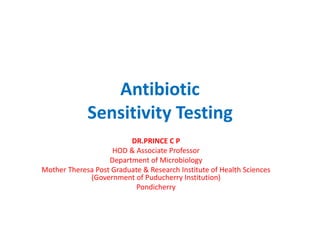Antibiotic sensitivity test PPT by Dr.C.P.PRINCE
Antibiotic sensitivity test: in vitro testing of bacterial cultures with antibiotics to determine susceptibility of bacteria to antibiotic therapy. A laboratory test which determines how effective antibiotic therapy is against a bacterial infections. Antibiotic sensitivity testing will control the use of Antibiotics in clinical practice Testing will assist the clinicians in the choice of drugs for the treatment of infections. Helps to guide the Physician in choosing Antibiotics The accumulated results on different pathogens their sensitivity will guide the physician in choosing empirical treatment in serious patients before the individual’s laboratory results are analyzed in the Microbiology laboratory. Reveals the changing trends in the local isolates. Helps the local pattern of antibiotic prescribing. PPT Prepared by Dr.Prince.C.P Department of Microbiology Mother Theresa PG&RIHS Pondicherry

Recomendados
Recomendados
Más contenido relacionado
Similar a Antibiotic sensitivity test PPT by Dr.C.P.PRINCE
Similar a Antibiotic sensitivity test PPT by Dr.C.P.PRINCE (20)
Más de DR.PRINCE C P
Más de DR.PRINCE C P (20)
Último
Último (20)
Antibiotic sensitivity test PPT by Dr.C.P.PRINCE
- 1. Antibiotic Sensitivity Testing DR.PRINCE C P HOD & Associate Professor Department of Microbiology Mother Theresa Post Graduate & Research Institute of Health Sciences (Government of Puducherry Institution) Pondicherry
- 3. Antibiotic sensitivity test • Antibiotic sensitivity test: in vitro testing of bacterial cultures with antibiotics to determine susceptibility of bacteria to antibiotic therapy.
- 4. Antibiotic sensitivity test • A laboratory test which determines how effective antibiotic therapy is against a bacterial infections. • Antibiotic sensitivity testing will control the use of Antibiotics in clinical practice • Testing will assist the clinicians in the choice of drugs for the treatment of infections.
- 5. • MIC: Minimum inhibitory concentration • MBC: Minimum bactericidal concentration • SENSITIVE: the antibiotic can prevent the growth of Bacteria. • RESISTANT: the antibiotic fails to prevent the growth of Bacteria
- 6. MIC • Minimum inhibitory concentration in microbiology, is the lowest concentration of an antimicrobial that will inhibit the visible growth of a micro organism after overnight incubation. • Minimum inhibitory concentrations are important in diagnostic laboratories to confirm resistance of micro organisms to an antimicrobial agent and also to monitor the activity of new antimicrobial agent
- 7. 1. The identification of relevant pathogens in exudates and body fluids collected from patients 2. Sensitivity tests done to determine the degree of sensitivity or resistance of pathogens isolated from patient to an appropriate range of antimicrobial drugs 3. Assay of the concentration of an administered drug in the blood or body fluid of patient required to control the schedule of dosage
- 8. • Antibiotic Sensitivity Testing is Essential of selection of Antibiotics • Isolation and Identification of Bacteria precedes the selection of Antibiotic Testing Methods
- 10. Uses of Antibiotic Sensitivity Testing • Helps to guide the Physician in choosing Antibiotics • The accumulated results on different pathogens their sensitivity will guide the physician in choosing empirical treatment in serious patients before the individual’s laboratory results are analyzed in the Microbiology laboratory. • Reveals the changing trends in the local isolates. • Helps the local pattern of antibiotic prescribing
- 11. Why Need continues for testing for Antibiotic Sensitivity • Bacteria have the ability to develop resistance following repeated or subclinical (insufficient) doses, so more advanced antibiotics and synthetic antimicrobials are continually required to overcome them. • Resistance implies that the infection is not treatable with the tested Antibiotic because its MIC exceeds achievable safe tissue or urine levels.
- 12. METHODS • Diffusion test • Dilution test
- 13. Diffusion test • Disc diffusion • Well diffusion • Cup plate diffusion • Patch diffusion
- 14. Dilution test • Used to detect MIC and MBC • Agar dilution • Broth dilution
- 15. Disc diffusion • Kirby-Bauer antibiotic testing • Stokes comparative method • E-test
- 16. Kirby-Bauer • Kirby-Bauer methods A commonly used method in basic laboratories • uses antibiotic-impregnated paper discs to test whether particular bacteria are susceptible to specific antibiotics
- 17. Procedure • The bacterium is swabbed on the agar( Lawn culture method) and the antibiotic discs are placed on top. The antibiotic diffuses from the disc into the agar in decreasing amounts the further it is away from the disc. If the organism is killed or inhibited by the concentration of the antibiotic, there will be NO growth in the immediate area around the disc: This is called the zone of inhibition .
- 19. Lawn culture
- 22. Zone of inhibition- measurement
- 24. Stokes comparative method • In the Stokes controlled sensitivity test, a control organism is inoculated on part of a plate and the test organism is plated on the remainder. Disks are placed at the interface and the zones of inhibition are compared. The use of a sensitive control shows that the antibiotic is active, so that if the test organism grows up to the disk it may safely be assumed that the test organism is resistant to that drug.
- 26. Multidisc
- 27. The Antibiotics are diluted to various dilution to test the minimum inhibitory concentration
- 28. Epsilometer test • E test is an antimicrobial gradient technique in which 15 reference MIC dilutions of an antibiotic have been repackaged with innovative dry chemistry technology onto a plastic strip. • The predefined gradient provides precise and accurate assessment of antimicrobial activity against both fastidious and non-fastidious microorganisms.
- 29. E test The strips are impregnated with various concentration of Antibiotics
- 30. automation
- 31. automation
- 32. Thank you
